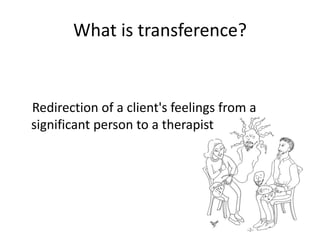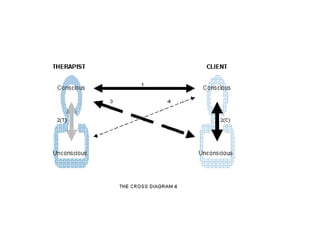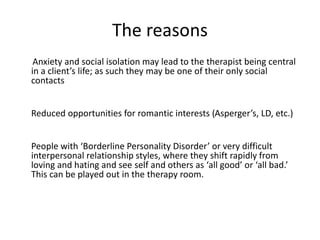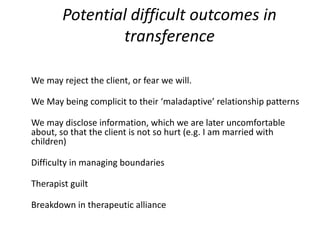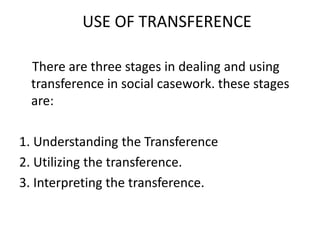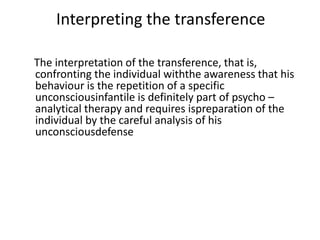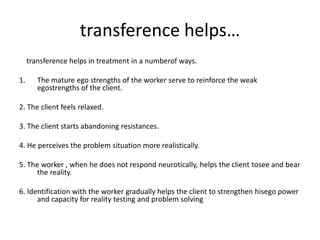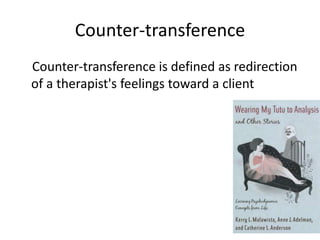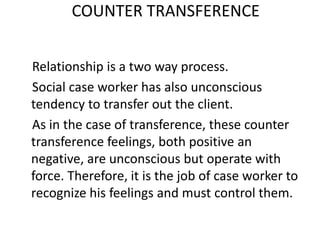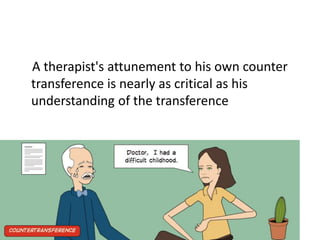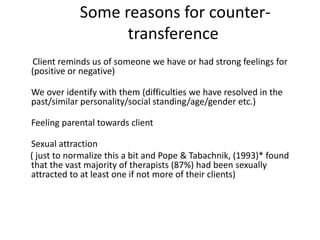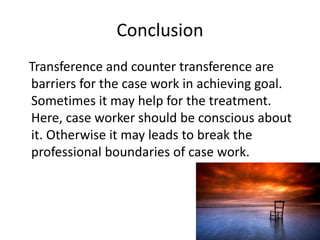- 1. Transference
and Counter-Transference
Thasleem
1st MSW
Central University of
Kerala
- 2. What is transference?
Redirection of a client's feelings from a
significant person to a therapist
- 3. In detail..
Transference is often manifested as an erotic
attraction towards a therapist, but can be
seen in many other forms such as rage,
hatred, mistrust, parentification, extreme
dependence, or even placing the therapist in a
god-like or guru status.
- 4. TRANSFERENCE IN SOCIAL WORK
‘Transfer’ was introduced into social work
literature by Jessie Taft in1924 who described
it as “an emotional relationship to the client”.
- 5. Hamilton defines transference as a carrying
over of irrational elements from other,
relationships, particularly in the past,
displaced on to the social worker, reflecting
unconscious motivation.
- 6. In this sense, the therapeutic relationships
would be viewed as a transference
relationship, as opposed to a real relationship,
thus permitting the worker to insulate himself
or herself from any true reactions and
personally meaningful interactions with the
client
- 7. an example
A from a home where his father was an arrogant and
domineering person. As a man the client has never
been able to get along with his boss or any other
figure of authority. In the case work situation, he
transfers to the case worker hostile feelings of the
type of he originally felt toward hi father and accuse
the case worker of the same arrogant treatment at
the hands of his father
- 9. Because the transference between patient
and therapist happens on an unconscious
level
- 10. The reasons
Anxiety and social isolation may lead to the therapist being central
in a client’s life; as such they may be one of their only social
contacts
Reduced opportunities for romantic interests (Asperger’s, LD, etc.)
People with ‘Borderline Personality Disorder’ or very difficult
interpersonal relationship styles, where they shift rapidly from
loving and hating and see self and others as ‘all good’ or ‘all bad.’
This can be played out in the therapy room.
- 11. Continue..
Clients may have low self-worth, and feel that
you as the therapist are a good role model
and over identify with you.
We may be asking clients about very difficult
things that evoke negative emotions. We then
may be central in re-experiencing those
emotions, almost as if we are the
personification of them
- 12. Potential difficult outcomes in
transference
We may reject the client, or fear we will.
We May being complicit to their ‘maladaptive’ relationship patterns
We may disclose information, which we are later uncomfortable
about, so that the client is not so hurt (e.g. I am married with
children)
Difficulty in managing boundaries
Therapist guilt
Breakdown in therapeutic alliance
- 13. USE OF TRANSFERENCE
There are three stages in dealing and using
transference in social casework. these stages
are:
1. Understanding the Transference
2. Utilizing the transference.
3. Interpreting the transference.
- 14. Understanding the Transference
Understanding of the transference is essential for the
worker as it helps to understand the behaviour of the
client and to recognize its significance in his
development process.
It also explains the present unconscious needs of the
client. Understanding of the transference of factors i.e.
the present behaviour and problem, the environmental
forces, the past experiences and earlier relationships
- 15. Utilizing the transference
Utilization of the transference depends on the
understanding of the social case worker of the
phenomena.
It explains many cures or treatments
of emotional disturbance by life situations and
by fortune relationships with other problems
- 16. Interpreting the transference
The interpretation of the transference, that is,
confronting the individual withthe awareness that his
behaviour is the repetition of a specific
unconsciousinfantile is definitely part of psycho –
analytical therapy and requires ispreparation of the
individual by the careful analysis of his
unconsciousdefense
- 17. transference helps…
transference helps in treatment in a numberof ways.
1. The mature ego strengths of the worker serve to reinforce the weak
egostrengths of the client.
2. The client feels relaxed.
3. The client starts abandoning resistances.
4. He perceives the problem situation more realistically.
5. The worker , when he does not respond neurotically, helps the client tosee and bear
the reality.
6. Identification with the worker gradually helps the client to strengthen hisego power
and capacity for reality testing and problem solving
- 18. The effects of transference are many but it is
the leaven of treatment, nottreatment itself.
- 19. Counter-transference
Counter-transference is defined as redirection
of a therapist's feelings toward a client
- 20. it’s a therapist's emotional entanglement with
a client
- 21. COUNTER TRANSFERENCE
Relationship is a two way process.
Social case worker has also unconscious
tendency to transfer out the client.
As in the case of transference, these counter
transference feelings, both positive an
negative, are unconscious but operate with
force. Therefore, it is the job of case worker to
recognize his feelings and must control them.
- 22. A therapist's attunement to his own counter
transference is nearly as critical as his
understanding of the transference
- 23. For example, if a male therapist feels a very
strong sexual attraction to a female patient,
he must understand this as counter
transference and look at how the client is
attempting to elicit this reaction in him
- 24. Some reasons for counter-
transference
Client reminds us of someone we have or had strong feelings for
(positive or negative)
We over identify with them (difficulties we have resolved in the
past/similar personality/social standing/age/gender etc.)
Feeling parental towards client
Sexual attraction
( just to normalize this a bit and Pope & Tabachnik, (1993)* found
that the vast majority of therapists (87%) had been sexually
attracted to at least one if not more of their clients)
- 25. Potential Difficult Outcomes of
Counter-transference
Blurred boundaries
Inappropriate levels of disclosure that compounds transference
Not working with the countertransference
Not acknowledging the countertransference
Therapeutic alliance breaking down
Unable to discuss case reflectively in supervision
Reinforcing Client’s and own relationship patterns
Difficulty ending therapi
- 26. What can we do?
Ask yourself:
Am I responding in a way that feels like me?
Do I associate this client with anyone else?
What feelings do I have about them?
Are those feelings only those that I as a professional have towards all my clients or
are there differences?
Why am Feeling this?
How is it impacting on my work with this client?
- 27. What can we do?
Use supervision, more, not less
Reflective and reflexive practice is key
Accept that feelings towards a client is normal,
and work with that
Talk about the relationship in the therapy room
Be consistent with boundaries
- 28. Conclusion
Transference and counter transference are
barriers for the case work in achieving goal.
Sometimes it may help for the treatment.
Here, case worker should be conscious about
it. Otherwise it may leads to break the
professional boundaries of case work.


